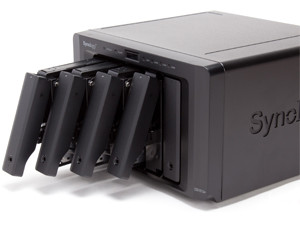
Every office needs more storage, and everyone is familiar with the impact of lost data. A popular option for quick expansion, particularly in branch offices and smaller companies, is network-attached storage (NAS) systems, which offer a subset of storage capabilities (sometimes little more than Windows file sharing) and sometimes a degree of resilience like RAID storage.
The Synology DS1513+ is such a NAS unit - a compact and nearly silent chassis offering five drive bays, supporting up to 30TB of storage. It comes with a custom interface, and a surprising depth of features which rapidly turn it from a simple filestore into a full-fledged Internet/intranet server, if you are so inclined.
Aimed at the upper end of the SME market, the unit offers five hot-swappable drive bays, four Gigabit Ethernet ports, and a number of expansion ports (four USB 2, two USB 3, and two eSATA ports) which can host additional storage. In particular, it can be extended by hooking Synology's own expansion units, offering up to five additional bays each, to the eSATA ports, potentially tripling its storage capacity at a great deal lower cost than purchasing multiple NAS devices.
We tested the unit with four WD Red 6TB drives - these are specifically optimised for consumer NAS environments, with a different caching and power profile than you'd find in desktop or server drives. There is no difference in price between these and other WD drives - just a small performance boost based on the expected and potentially improved lifespan too, so it's worth ensuring you have the right drive for the job. The WD Red drives offer 64MB cache and a 6GBps SATA III interface.
In testing, we routinely saw sustained read and write speeds in excess of 100MBps. With link aggregation across all four Ethernet ports, the unit promises over double that, with higher performance on writing than reading. That's very good performance, even in a multi-user environment - you'd need a tuned storage server to beat it.
Synology uses BusyBox Linux as the underlying OS, building a complete Web interface on top to control all aspects of configuration. The basic setup is quick and easy, but you get into more complex territory quickly - one area which could use improvement is in wizard or quick-start interfaces. This is a more advanced product than might suit a completely hands-off user. Setting up partitions and preferences is all fairly painless, but does require some knowledge of LUNs and RAID groups, for example. The DS1513+ supports the usual range of RAID options (0-5) as well as its own "Hybrid RAID", which optimises RAID options based on the drives available. In testing, this performed roughly on par with RAID 5, with the 100MBps+ speeds we discussed.
All the basic sharing options you might expect are present - Windows file and print sharing all works out of the box. But numerous other options are also either bundled, or available through downloadable software modules. The unit supports Apple Time Machine backups, for instance, and a variety of cloud storage options for synchronisation or remote access. Backup software, antivirus and network utilities like DHCP/DNS servers are also available - this turns into a fully-fledged server appliance very quickly, and all the modules are exposed through the same Web interface. The system supports IP cameras and can operate as a surveillance station...there are many more applications available than we could list here. Not all are of equal quality - the Synology user forums are a good place to head for recommendations.
The system ships with 2GB of RAM, sufficient for all basic storage tasks, but some of the heftier software (streaming entertainment with media transcoding, for example) will exhaust that easily. You can upgrade the memory to 4GB: it's just standard DDR3, accessible through the top of the unit.
The drive bays are hot-swappable, and the unit alerts quickly and cleanly when a drive fails or is removed - pop-up messages explain which drive needs attention, and which storage groups will be affected. Just pop in a new drive, and the RAID group rebuilds automatically.
The unit boasts dual fans, but unfortunately does not offer redundant power supplies - we would have liked to see that included. In practice, you'll almost certainly want to deploy this on a UPS for power protection.
Prices start at around R12 000 for the chassis - a considerable saving over what you'd spend on a server with the same capabilities. If you need comparable features for less, a stripped down microserver running FreeNAS might get you there, but the technical skills required will be much greater. The 6TB WD Red drives retail for around R4 000 apiece.
This is definitely a package worth considering for small-to-mid range enterprise NAS requirements, or SMEs of any size.
Share